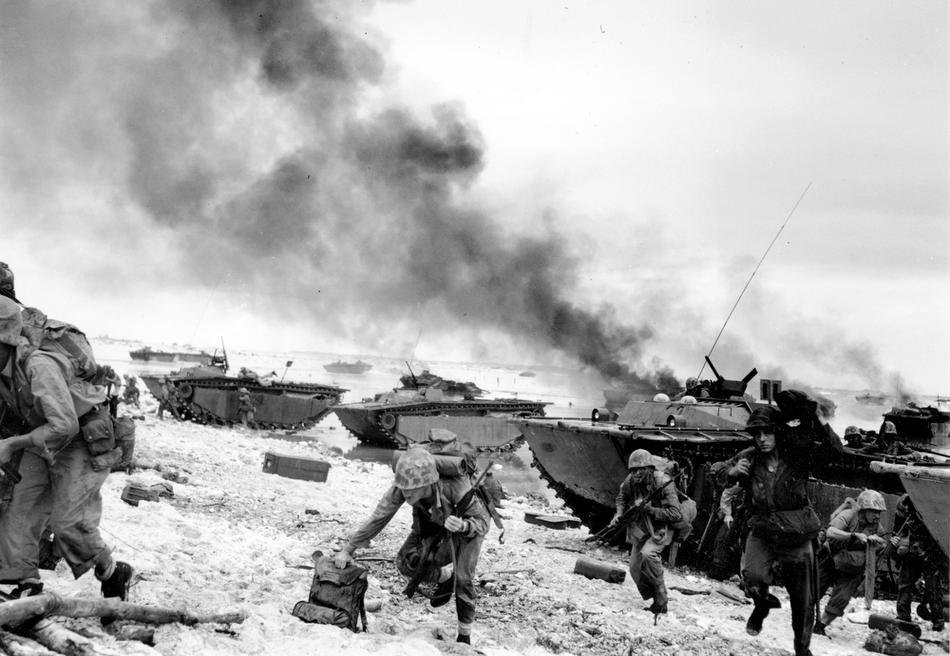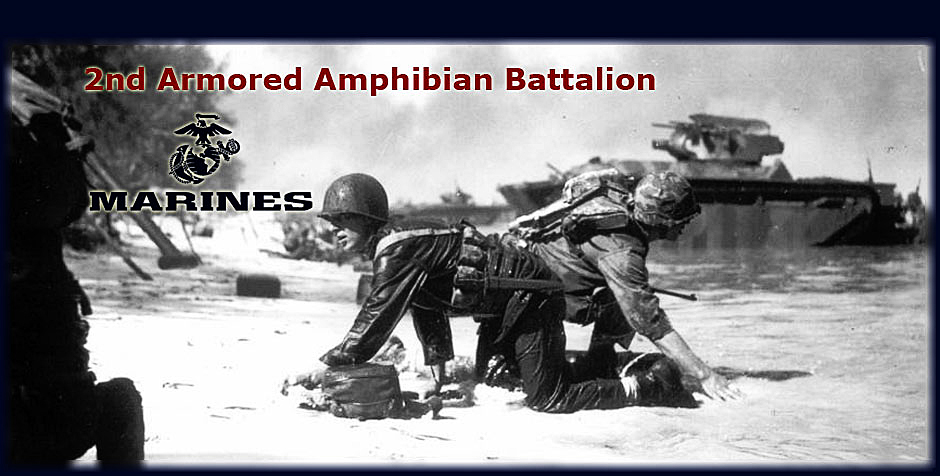THE LVT(A)4 ARMORED AMPHIBIAN TANK (USMC)
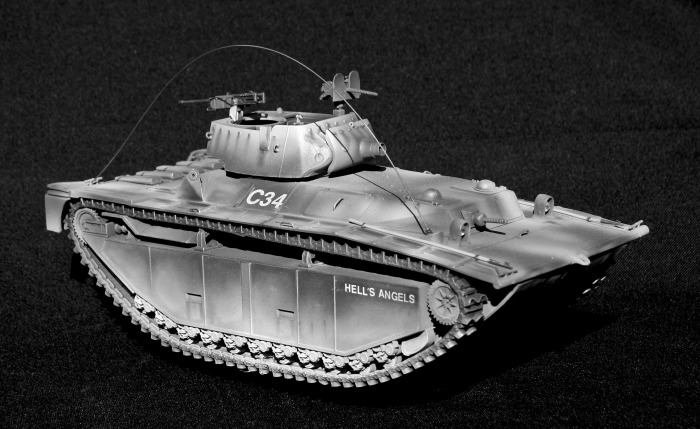
Model Handcrafted by R. Bishop (modelcrafters.com and Flickr) (Click arrows flanking model for slideshow)
PART A -
LVT(A)4 BASE SPECIFICATIONS:
Crew:
Driver occupies right front seat, Radio operator who's also bow machine gunner occupies left front seat.
1 or 2 Ammo passers occupy rear center compartment, along with gear and ammo, the latter including 75 howitzer shells (high explosive, armor piercing, cannister & smoke).
In the turret: the Loader is left; Gunner is right; Tank Commander in 50 Cal. swivel ring.
Note: Passengers in rear center compartment during a combat beach run may also include corpsman, mechanics, and other battle critical Battalion personnel.
Armament:
Turret mounted M-8 75mm Howitzer (30" barrel in 20" flash hider), 50 cal. machine gun, and 1 or 2 swivel mounted 30 cal. machine guns;
Plus one forward mounted 30 cal. machine gun manned by radio man;
Plus 2 light machine guns fired out side hatches of center compartment for close in combat.
Plus Crew side arms for side hatch, topside or dismounted use: Thompson sub-machine guns, 45 automatic pistols, M1 rifles, carbines & grenades.
 Click to EnlargeBase Specifications: 26' 2" long, 10' 8" wide, 10' 2.5" high; 40,000+ pounds fighting weight fully loaded.
Click to EnlargeBase Specifications: 26' 2" long, 10' 8" wide, 10' 2.5" high; 40,000+ pounds fighting weight fully loaded.
Power train: Spicer synchro-mesh transmission with 5 forward speeds and 1 reverse up front between Driver and Radio man with drive shaft back through 2 fire walls to engine in vehicle's rear. Driver shifted and powered vehicle by working left foot clutch pedal and right foot throttle and steered by pushing left handed lever to turn left or right handed lever to turn right and halted vehicle by pulling back both levers.
Engine: radial, air-cooled, 250 hp, W670 Continental aircraft engine.
Range & Speed - 150 land miles, 100 sea miles; 15+/- mph on land, 3.5-7 mph on water (depending on conditions).
PART B -
PERTINENT BATTALION C0 Correspondence RE: LVT(A)4 BEFORE SAIPAN:
17 MARCH 1944 Headquarters Marine Corps, WASH. DC, letter to Lt. Col. Reed M. Fawell, Jr., Battalion Commander
Lt. Col. Fawell, "With regard to your (request) for 2.5 ton 6X6 Machine Shops ... three are en route ... these three, plus two machine shops trailers, are the best that can be done at this time ... It is unfortunate that you cannot get the training time you ought to have, but Cincpac says he will not delay your (departure) date. Evidently you will do considerable training after you leave (Continental US) ... The gyro-stabilizer for the (75mm Howitzer) for (effective waterborne firing) is 6 to 9 months away ... By Lt. Col. Harvey S. Walseth
5 MAY 1944 Headquarters Marine Corps, WASH. DC, letter to Lt. Col. Reed M. Fawell, Jr., Battalion Commander, after his 3 May meeting with Gen. Holland M. Smith, Commanding General, Fleet Marine Force, Pacific, and V Amphibious Corps
Lt. Col. Fawell, "Today a dispatch came through the Marine Supply Service, Fifth Amphibious Corps ... telling about fire control equipment supply difficulties. When on the West Coast visiting you, I told you it was the Depot Quartermasters job to see that your LVT(A)4s were properly equipped with the necessary fire control equipment, given that all of it had been authorized and was under procurement. As soon as we found out today about your situation, we started a fire under the Quartermaster to expedite supply of the missing equipment. It appears that the Depot Quartermaster, San Francisco, is responsible for not getting the stuff out with your vehicles. Every effort is being made to see that you are supplied by air.
By the time this letter reaches you, I hope everything required is in route to you. I am forwarding you a copy of the organization combat equipment authorized for the LVT(A)4 ... In the 1 April Readiness Report you listed certain items as being essential but not authorized. The copy of your organizational combat equipment lists most of these items. A few items have not been authorized because this Headquarters does not consider that the armored amphibian battalion should be set up with sufficient fire control equipment for a fire direction center as are artillery units. Your weapon is a special weapon and primarily a direct fire one ... so you will have to cooperate with any artillery regiment or battalion ... in your vicinity. When a combat team to which you are attached desires you to fire on a field artillery mission, a field artillery liaison group will have to help you out.
I trust your movement overseas was satisfactory and that you are now set up in a permanent camp and engaged in advanced unit training. I would be interested in hearing from you, describing any difficulties you may encounter. Given that Fifth Amphibious Corps promised that you would have sufficient time to accomplish your advanced training, I am particularly interested in how you make out. By Lt. Col. Harvey S. Walseth
28 MAY 1944 Fleet Marine Force, Pacific, letter to Headquarters Marine Corp, Wash. DC, to get action on concerns expressed by Lt. Col. Reed M. Fawell Jr. as his battalion sailed for Battle:
Lt. Col. E. M. Shedeker, When the 2nd Armored Amphibian Battalion was activated 24 January 1944, the San Diego Area A-3 instructed its Battalion Commander that he was to be prepared to depart for Hawaiian Area on 1 April 1944. Before that time, he was to complete Basic Training (driving and the school of the soldier). Advanced Training (tactics, formation driving, and gunnery) would be (done after) his arrival in the Hawaiian Area. He was also told that his LVT(A)4s would be shipped from the Riverside factory to San Francisco (where) all ordinance (and radio) installations would be completed ... and all vehicles would be entirely completed in all respects, ready for action when delivered to his Battalion.
On April 1 the Battalion was crated up ... to move overseas per orders ... On 24 April all the Battalion's general cargo was shipped ... to destination PEAK 83. On 26 April all personnel with their individual equipment embarked on APA 166 for PEAK 83. Upon arrival on 2 May ... at PEAK 83, the D-3 of the 2nd Marine Division came aboard and informed the Battalion Commander that his Battalion would embark on 13 May for maneuvers. At this time the Battalion had never seen its LVT(A)4s (nor) fired its 75mm Howitzers. .. . (and its) general cargo had been rerouted to FRAY (so had also not arrived). (The following day) 3 May the Battalion Commander flew to Headquarters, Fifth Amphibious Corps, to submit a readiness report. While there, he learned that the LVT(A)4s were in route. On 3 May he submitted a complete list of all shortages to the 6th Base Depot.
On 4 May the Battalion received 68 LVT(A)4s from the 6th Base Depot. Every vehicle was in condition it had left the factory at Riverside, that is minus the following: All periscopes, all telescopes, all 30 and 50 caliber machine guns, all direct and indirect fire control equipment, all blast shields for vision domes, all bow guns, all communications accessories, and none of the vehicles had dual radio receivers or transmitters.
Between 4 May and 13 May the Battalion serviced all LVT(A)4s, and installed bow guns, blast shields for periscope domes, 30 Cal. machine gun mounts, etc. ... obtained from the 2nd and 4th Marine Divisions. On May 12 the Battalion received the first equipment requested on 3 May. This consisted of 40 M70c telescopes, and 60 panoramic sights. On 5 May the Battalion commenced its Advanced Training, consisting of gunnery, tactics, and formation driving. This was completed at 1300 on 10 May. Thus, Advanced Training amounted to what gunnery, tactics, and formation driving that its Battalion Commander was able to get across in a period of five and one half days (before he had to pack up and depart for maneuvers).
At 0600 13 May the Battalion commenced embarkation on 18 different vessels. Its general cargo had left Fray (but still had not arrived) and no equipment (other than 40 telescopes, 60 panoramic sights & 68 LVT(A)4s) had been received by the Battalion from 6th Base Depot. For gunnery training on maneuvers, each gunner and loader ... fired from 80 to 100 rounds ... (using sights off M3A1 light tanks) borrowed from 4th Tank Battalion. There is little similarity between these sights and (those) used by the 75mm tractor mounted Howitzer. The firing was wild due (in part due to the inexperience of personnel with the weapon), but principally because of (the lack of) gyro-stabilizers necessary for the accuracy during water-borne firing). The Battalion Commander estimates that two (shells hit the) beach for every 15 rounds fired when water-borne. It is strongly recommended that a suitable gyro-stabilizer be installed.
(The Battalions general cargo) was finally unloaded in FRAY on May 20, and even now it is in process of being distributed, given the wide dispersal of the Battalion on 18 difference vessels at sea. On 27 May the battalion received (aboard 2 of its 18 vessels) approximately 90 percent of the equipment shortages requested 3 May. Therefore a large percentage of this vital equipment remains to be distributed ...
Since its arrival in this (Hawaiian) area, this battalion had stressed aggressiveness in all of its training. The Battalion Commander had confidence in the ability of his men to produce in any situation where these vehicles are employed as tanks ... principally (because) a majority of (Battalion) officers and NCOs are ex-tank and artillery men (familiar with) ... armored vehicles.
The following recommendations are submitted:
1) That, in future operations, armored amphibian battalions be embarked on two LSDs or similar craft. This enables the battalion to divide its ordinance, maintenance, communications, and administrative sections into two parts, giving its battalion commander complete control over units until they are committed. Division naturally expects battalion commander to make corrections as a result of maneuvers, to brief the battalion, distribute confidential publications, supervise maintenance and repair, etc. This is impossible with battalion disbursed on 18 different vessels located in various parts of PEAK and FRAY.
2. That the LVT(A)4 power train and floatation be redesigned to match gross tonnage of vehicle. LVT(A)4s, loaded for combat, carry 125 rounds of 75mm ammunition (50 rounds of HEAT, 70 HE with M48 fuse, 5 smoke), plus small arms ammo, grenades, machine guns, and crew gear, which altogether gross over 20 tons. Yet the vehicles power plant and train were designed for 11 tons. As a result the troop carrying LVT(A)2, being one to two knots faster when waterborne, easily pass the LVT(A)4s on the run into the beach, masking the latter's field of fire. (In addition), in moderately rough water, the LVT(A)4 stern is continually awash due to lack of free-board. Its engine must run continually to drive its bilge pumps; otherwise (the vehicle) will sink in minutes. (Note: above sentences paraphrased.)
3. That all radio installations be made air-tight and water proof. Otherwise ... the two inter-com junction boxes in the turret will often short out due to salt water spray, burning the set out.
4. That means be found to prevent periscope domes from fogging up. Unless inter-com is working 100%, driver must open his front flap to see.
5. That battalion be authorized to convert portion of their LVT(A)2s into floationg machine shops and spare parts units. At present battalion is not able to carry their machine shops and spare parts trailers on maneuvers due to lack of shipping. LVT(A)2 machine shops could replace two LTV(A)4s on maneuvers.
6. Battalion will require additional personnel if waist guns be added to vehicle.
7. Battalion has never received its training publications, including TBA, a T/C, or any other training, technical, or ordinance publication manual.
By Lt. Col. William A. Kengler (Operations Officer, Fleet Marine Force, Pacific) to Lt. Col. E. M. Shedeker, Division of Plans and Policies, Headquarters Marine Corps, Washington DC
Note: portions of letter paraphased for brevity. Underlining added for emphasis. First paragraph reads: "These are the woes of the 2nd Armored Amphibian Battalion. The battalion commander, Reed Fawell, is an old friend of mine from Iceland, and a damn capable officer. You will see from this letter that he is having some tough sledding. He is no idle honker and there is little room for doubt of the truth of his statements from what I have seen. Here is the dope."
PART C -
SUBSTANCE OF BATTALION SAIPAN AFTER ACTION REPORT, submitted by Battalion CO Reed M. Fawell, Jr 21 July, 1944 (3 days before Tinian Landing):
1. Landing Mission: Land in the first wave with assault troops in LVTs, move to tractor control line some three hundred yards inland, cover the debarkation of the assault troops from LVTs, and support advance of Infantry to the O-1 line. All companies and platoons given definite missions up to Tractor Control Line, and some given specific areas to fire on beyond this line, although most platoons were ordered to remain in cover near this line and engage targets on call from infantry.
2. Approach and Landing: Amtanks had no difficulty negotiating reef. In the lagoon amtanks in echelon were compressed almost into column and some LVTs, given their faster speed, crossed in front of Amtanks, masking their fire at beach. Approaching beach Amtanks encountered shell fire from guns and mortars inland, and direct fire from field pieces, AT guns, and small arms fire on beach. Those amtanks that did fire commenced at 300 yards offshore (on average.) 3 Amtanks disabled in lagoon. (leftward shift noted) On beach some Amtanks stopped by trees, trenches, shell holes on beach, or were unable to manuever to find passage off beach because of stopped LVTs discharging troops onto beach or troops digging in at beach. 28 Amtanks disabled between beach and tractor control line. Few, if any, troop carrying LVTs got this far. Infantry remained in close contact with Amtanks up to Tractor Control Line. 18 Amtanks got beyond Tractor Control Line. They received little Infantry support. Moving inland, and after reaching Tractor Control Line, Amtanks fired on houses, pillboxes, dugouts, gun positions, tanks, and other enemy installations, some targets designated by Infantry. Two Amtanks penetrated 1500 yards in from Red Beach 3.
3. After initial Landing: Amtanks employed in Lagoon defending against counter landings at night, on beach in stationary positions, and on beach flanks supporting advancing infantry.
Pertinent Remarks:
1. Amtank Armament:
75 mm Howitzer: Absent gyro-stabilizer, seaborne firing not very effective. This problem compounded by trouble locating targets through heavy smoke and dust (from heavy gunfire into shore), periscopes and sights fogging over, as well as LTVs and Amtanks moving ahead masking fire. Ashore, these problems vanished, save as noted below. Gunners seldom required more than two or three rounds to get on target at ranges up to 2000 yards, despite the fact they'd never used M70C sight before D-day and few guns were boresighted. 75 mm rounds of HEAT disappointing. 3 enemy tanks took 10 to 15 hits at ranges under 300 yards before lit afire and halted. 8 cocking springs failed on 75 mm, requiring firing by lanyard. Electric firing device failed on 20 amtanks. Elevating and traversing handwheel on 75 mm sometimes off target. Turret traverse too slow, causing frequent loss of target. Remedy requires a power traverse. M70C telescope field of vision inadequate, requiring some gunners to look over turret to find targets. Periscopes mounted coaxially in tandem with gunsight should remedy problem. Semi-fixed ammo caused jams. Fixed ammo necessary for direct fire.
Bow 30 Cal. Machine Gun: Limited traverse of weapon limits engagement of many targets. Fragility of periscope also limits weapons ability to engage targets. Specifically, 90% of weapons periscope fell out, broke or clouded over in combat. Remedy is cutting vision slits in front of radio driver. Ammunition box serving radioman gunner placed too low, caused shell feed to jam frequently. Remedy is lifting ammo box jacket.
50 Cal. turret Mounted Machine Gun: 95% of amtank commanders say this weapon, in its current ring mount, is too difficult to handle against ground targets. If amtank is tilted on rough terrain, it's very difficult to swing weapon uphill to engage target. Loading weapon is also very dangerous and awkward in combat. Tank commander must expose half his body to enemy fire to reload his weapon.
Overall firepower: There is overall need for more small arms firepower on amtanks, given the current above limitations. Suggested remedy is two 30 Cal. machine guns mounted on lower ring in turret. The traverse of a single side mounted 30 Cal. typically limits fire to one side of vehicle.
2. Armor: Heavier armor needed, particularly if amtank deployed inland. Small arms fire on Saipan penetrated hull, wounded crew, and disabled some amtanks. Remedy: .25 inch more armor for bow and sides.
3. Side-arms: Thompson Sub-Machine Gun proved very useful against close enemy troops. Most crew would prefer 45 automatic pistol to carbine, to ensure that crew can evacuate quickly with sidearm.
4. Communication:
External Radio Communication: Very poor. Battalion allowed only one frequency. And it required delicate tuning that was frequently unset by jarring of Amtank crossing reef, lagoon, and ashore. Remedy: a broader and more stable tuning band. Sets also failed due to poor waterproofing, principally in remote control units, junction boxes, microphones, and headsets. Vertical whip antenna interferes with turret firing (four shot off), but antenna in horizontal mode diminishes power and range. Wafer headphones failed to muffle outside noise. Many radio operators had only two days training in vehicle which hampered performance. 18 radios failed completely from water and other causes. Typically infantry designated targets to amtank gunners by hand signals.
Internal Radio Communication: poor. TCS failed in at least 14 vehicles. Remedies: Rubber tubes rigged from turret to driver worked fairly well when TCS failed. Some crews signalled through reins from turret to driver with good results when TCS failed. Passing word from tank commander to driver via ammo passer was least successful. Most ammo passers removed awkward or failed headsets and passed ammo by hand signals.
5. Mechanical Failure:
Engine: Only one engine failed absent enemy fire.
Clutch: 7 amtanks suffered total clutch failure. 26 others were seriously impaired during operations on Saipan by clutch failure. Easily overheated, clutches slipped or refused to engage, forcing driver to shut off the engine to stop the Amtank, exposing it to heavy enemy fire. In many cases, driver forced to wait up to an hour before clutch cooled sufficiently for amtank to move (or determine that it would not engage without repair).
Transmission: Overheated excessively, in many cases dropping oil pressure to zero even though transmission full of oil. Excessive heat in cab caused one crewman death, many burn cases, and affected crew operations.
Final Drive: Obstacle broke one final drive, disabling Amtank.
Brakes: 6 amtanks had brake trouble. 3 brakes froze, causing Amtank to turn in circles. All remedied in field and kept operating.
Suspension Systems: 5 damaged for reason other than enemy fire, but were able to operate.
Auxiliary Generator: 12 burned out during combat operations. Auxiliary Generator must run continously to operate radio and more than 30 continuous minutes to keep Amtank's battery charged. But such operation is impractical, and risks generator failure. Use of 100 octane gas likely contributes to problem.
6. It is Recommended that:
Regarding Deployment:
Battalion should transit to battle in 2 LSTs, if available, or in 5 LVTs if LSTs not available. In either case, there should be sufficient space for Battalion Amtanks, its LVTs, and its maintenance equipment, so as to brief crews and supervise their last minute maintenance. The transit to Saipan in 18 vessels made this impossible.
Amtanks should be in own first wave, landing a few minutes ahead of infantry. This will prevent the faster LVTs from overtaking and masking Amtank fire going to beach and will prevent later LVT congestion (including dismounted infantry) on the beach from masking amtank fire. Tactic will also allow amtanks to maneuver just offshore and on beach as necessary to gain access across and off the beach, and will better insure effective fire that destroys enemy weapons on beach and diverts the enemy's attention from disembarking troops.
Amtanks should have definite and exact instructions on where to go and what targets to hit after crossing beach. If used in general support missions, they should remain in concealed rear positions until specific targets are designated for them. Then they should move forward and engage specified targets, and withdraw back into concealed position as their exposed position draws heavy fire.
After land tanks are ashore, Amtanks (given their vulnerability and poor mobility ashore) should not be used as land tanks, except in emergency. In all cases, while amtanks can undoubtedly be effective as land tanks on beach (or within few hundred yards of it) they should be used farther inland only as mobile supporting guns, if at all. If personnel are trained and equipped, amtanks can be used effectively for indirect fire until artillery is landed.
Regarding Vehicle:
Vehicle is definitely under-powered, thus stopped by obstacles a land tank can easily negotiate. Suggest a Guiberson diesel engine to provide more power, greater range, less fire hazard, and also stronger clutch, and more efficient transmission less prone to overheating. Also radio with wider frequencies (5 band wide), more durablity, better waterproofing, and antennae mounted clear of turret, as radio communication essential to control of amtanks. Need install separate gas tank for auxiliary generator. Need better vision system for driver, radio man, and tank commander: a combination of slits, indirect or protected vision devices, and wide view periscope mounted for all around vision. Replace 50 Cal. machine gun with 30 Cal. machine gun, scarf waist guns suggested. Water proofed electrical firing key should be installed on elevating or traversing handwheel. Install Gyro stabilizer and power traverse on turret to control 75 mm Howitzer when on the move, especially sea-borne. Fixed 75 mm H.E. ammo needed. Normal ammo load should be 80% M48HE, 15% HEAT, 5% Smoke. Battalion requires a medium tank retriever, and operations officer added to Armored Amphib TO. Better latch togs, ammo box brackets, rubber headsets needed plus 45 automatic pistols for all crew.
By/ Lt. Col. Reed M. Fawell, Jr 21 July, 1944
PART D - PERTINENT SAIPAN AFTER ACTION SAIPAN REPORTS OF SUPERIORS:
From Commanding General, Northern Troops and Landing Forces in the field 12 August 1944 to Commander in Chief, US Pacific Fleet, via intermediate commands (Gen. Holland Smith, Adm. Richmond Kelly Turner & Adm. Raymond Spuance) re: Marianas Phase I (Saipan); page 22(1)...e. The Amtanks with the 75mm How mounted LVT(A)(4) proved far superior to the Amtanks with the 37mm mounted LVT(A)(1). The fire of the 75mm How is more effective against beach implacements and in several instances Japanese tanks were engaged and destroyed. The 37mm does not provide the fire power needed in the initial phase of landing. It is recomended that the 75mm How Amtank be continued in production and that experiments be conducted to determine if the 105mm How can be mounted in the Amtank. The Amtanks are not adequately armored and recommendations for increased armor protection has been forwarded by separate communication.
1st Endorsment, dated 18 October 1944, from Commanding General Holland M. Smith, Fleet Marine Force, to Commandant Marine Corps re: Comments of officer returning from overseas "on supporting arms and equipment since days of Guadalcanal as observed by Major W. S. Vasconelles, USMC, during Saipan, Tinian operations: ... 1. Supporting Arms: ... (e) Amphibian Tractors (1) Armored Amphibian Tractor (LVT(A)(4) mounting 75mm cannon were invaluable as a mobile gun accompanying assault waves.
Report HQ Expeditionary Troops Task Force 56, by G-3 on Forager, Enclosure B - HQ Fleet Marine Force Pacific re Operations for Capture, Occupation, and Defense of Saipan: ... The assault LVTs were preceded by a wave of armored amphibians which provided valuable support with their 75mm howitzers and 37 mm guns. (Note: reference to 37 mm guns refer to 708 Amphibian Tank Battalion that preceded 4th Marine division onto Yellow and Blue Beaches south of Afetna Point on southern flank of Saipan landings.)
PART E - ALL THIS SECTION UNDER CONSTRUCTION AND FORMATTING
TABLE OF BATTALION ORGANIZATION & EQUIPMENT dated 31 December 1943 as updated 14 April 1944
Headquarters & Service Company:
COMMISSIONED OFFICERS:
1 Lieutenant Colonel; 1 Major; 2 Captains; 5 Lieutenants. Total Commissioned Officers: 9
COMMISSIONED WARRANT OR WARRANT OFFICERS
3 Warrent Officers Total Warrant Officers: 3
SNCOs:
1 Sergeant Major, First Sergeant, Master Gunnery Sergeant,
1 Master Technical Sergeant, Quartermaster Sergeant, Gunnery Sergeant,
1 Staff Sergeant, 2 Technical Sergeants. Total Senior Non Comissioned Officers (SNCOs): 9
NCOs:
21 Sergeants
27 Corporals Total Non Commisioned Officers (NCOs): 48
COOKS: 1 Chief Cook, 1 Field Cook, 2 Assistant Cooks Total Cooks: 4
PRIVATES:
47 Privates 1st Class/Privates Total Privates: 47
Total Enlisted: 108
TOTAL HQ & SERVICE COMPANY MARINES: 120
LINE COMPANIES A, B, C, & D:
COMMISSIONED OFFICERS:
4 Captains; 16 Lieutenants. Total Commissioned Officers: 20
COMMISSIONED WARRANT OR WARRANT OFFICERS
4 Warrent Officers Total Warrant Officers: 4
SNCOs:
4 First Sergeants, 8 Gunnery Sergeants, 4 Technical Sergeants
12 Platoon Sergeants, 12 Staff Sergeants Total Senior Non Comissioned Officers (SNCOs): 40
NCOs:
132 Sergeants
184 Corporals Total Non Commisioned Officers (NCOs): 316
COOKS: 4 Chief Cook, 4 Field Cook, 2 Assistant Cooks Total Cooks: 4
PRIVATES:
47 Privates 1st Class/Privates Total Privates: 316
Total Enlisted: 684
TOTAL LINE COMPANY MARINES: 708
TOTAL BATTALION MARINES: 828
COMMISSIONED US NAVY:
1 Medical Corp; 1 Dental Corp. Total US Navy Commissioned Officers: 2
ENLISTED PERSONAL US NAVY
1 Chief Pharmacist's Mate, 1 Pharmacist's Mate, 1st Class, 1 Pharmacist's Mate, 2st Class,
1 Pharmacist's Mate, 3rd Class, Hospital Apprentice, 1st Class, Total US Navy Enlisted Personnel: 12
TOTAL BATTALION PERSONAL: 840
DISMOUNTED WEAPONS:
CARBINE, .30-caliber, M1:
HQ&Service Company - 85
4 Line Companies - 568 TOTAL BA. CARBINES 653
GUNS, Machine, .50 Caliber, Browning, M2, heavy barrel, flexible:
HQ& Company - 4
4 Line Companies - 12 TOTAL BA. DISMOUNTED 50 CAL MACHINE GUNS 16
ARMORED AMPHIBIAN w/armament:
HQ&S Company - 3
(TCS radio equipped - 2)
4 Line Companies (16 per Co) - 72 TOTAL BA. AMTANKS - 75
(TCS radio equipped - 4)
PUMP SET, centrifugal, self-prime, gas driven, 55 gal.pm
HQ&Service Company - 1
4 Line Companies - 4 TOTAL BA. PUMP SETS - 5
TRACTORS, Amphibian, with armament:
HQ&Service Company - 4 (1 radio equipped)
4 Line Companies - 8 TOTAL BA. TRACTORS 12
TRAILERS:
1 ton 2-wheel greasing (1 per Co.) - Total 5
1 ton 2-wheel high pressure cleaning unit (1 per Co.) - Total 5
1 ton 4-wheel stockroom (1 per line Co.) - Total 4
1 ton, 2-wheel water 300-gallon (1 per line Co.) - Total 4
2 ton, 4-wheel, stockroom - (HQ & Service Co.) - total 1 TOTAL BA. TRAILERS 19
TRUCKS:
1/4-ton, 4X4 (3 per Line Company) - Total 12
1/4-ton, 4X4 Radio equiped (2 HQ&S Company) - Total 2
1-ton, 4X4 Cargo (2 HQ&S Company) - Total - 2
1-ton, 4X4 Reconnaissance (2 HQ&S Company) Total 2
2 1/2-ton, 6X6 Cargo with winch (8 HQ&S Co., 12 Line Co) - Total 20
2 1/2-ton, 6X6 Machine Shop, M16A1 w Load "A" - (1 HQ&S Company) - Total 1
2 1/2-ton, 6X6 Gas Tanker (1 HQ&S Company) - Total 1
2 1/2-ton, 6X6, Wrecking - (1 HQ&S Company) - Total 1 TOTAL BA. TRUCKS 41
TABLE OF ORGANIZATION FOR EACH LINE COMPANY (A, B, C, & D):
COMMISSIONED OFFICERS:
1 Captain - HQ Section
4 Lieutenants - 1 per 3 platoons, 1 HQ section Total Commissioned Officers: 5
COMMISSIONED WARRANT OR WARRANT OFFICERS
1 Warrent Officer - Maintenence Officer (Maintenence Section) Total Warrant Officers: 1
SNCOs:
1 First Sergeant - HQ Section
2 Gunnery Sergeants (1 Ordinance amtank) (1 Chief, maintenence Section)
1 Technical Sergeant (1 Mechanic Chief, Maintenance Section)
3 Platoon Sergeants, (1 HQ & 5 squads,)
3 Staff Sergeants (1 engine mechanic, 1 Mess, 1 Radio Chief, All Maintence Section) Total Senior Non Comissioned Officers (SNCOs): 10
NCOs:
33 Sergeants
Co. Headquarters
(1 Recon, HQ), (3 amphib COs, Amphib Section)
(1 Blacksmith/Welder, 1 Machinist, 1 Amphib Mechanic)
(1 Artillery Mechanic, 1 Engine Mechanic, Motor Mechanic)
(3 Operators, Mechanic Radio, Machine Gunner (CP))(2-HQ, 1 HQ maintenence)
(1 Suppy & Property; Decontamination)(PtHQ & 5 sq)
46 Corporals Total Non Commisioned Officers (NCOs): --
(1 Armorer, 1 Carpenter, 2 Crew Chief amphib tractor) (PtHQ & 5 sq)
(2 ass. Crew Chief amphib tractor) (PtHQ & 5 sq)
(4 Driver ,
COOKS: - Chief Cook, - Field Cook, Assistant Cooks Total Cooks: --
PRIVATES:
- Privates 1st Class/Privates Total Privates: --
Total Enlisted:--
TOTAL LINE COMPANY MARINES: --
THIS SECTION UNDER CONSTRUCTION DAILY.
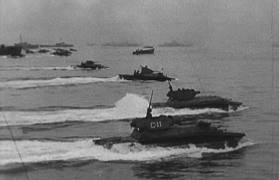
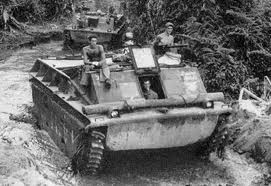
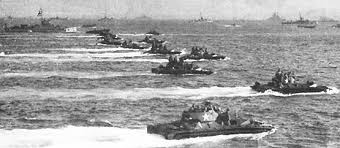
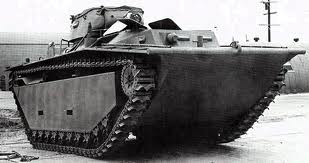
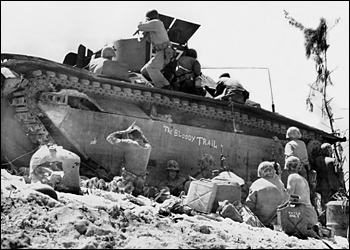
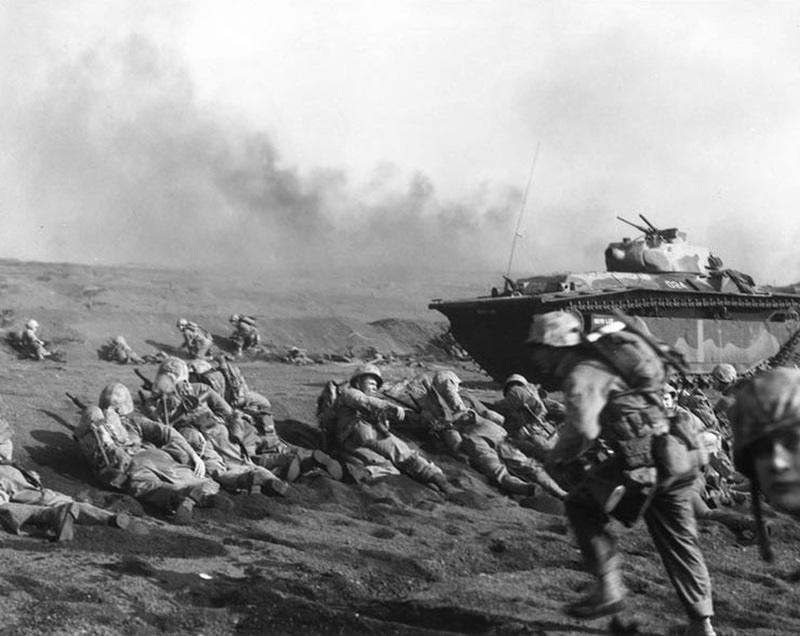

Note: Photo immediately above and below are of 3rd Armored Amphibian Battalion Amtank in action on Island of Pelelieu. Photos of other units in other battles used herein for purposes illustration will be noted and idenified as discovered and all notes edited. In addition, a history of WWII Amtank Battalions in the Pacific, including all such Marine Battalions and photographs, will be included in the Website found at amphibiouslanding.com
